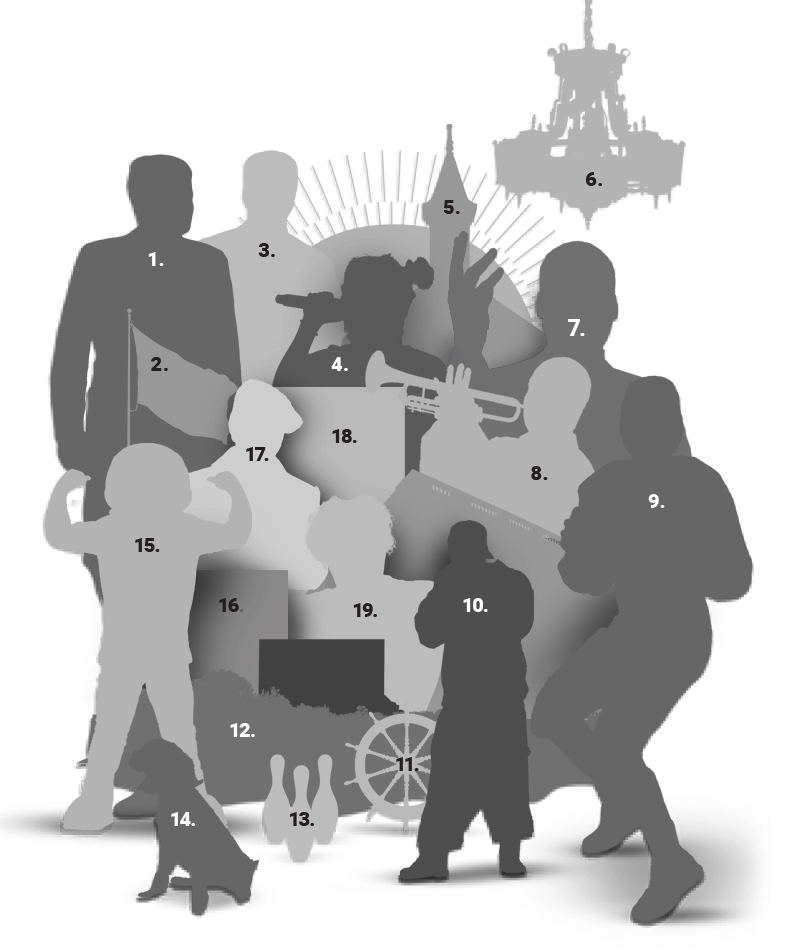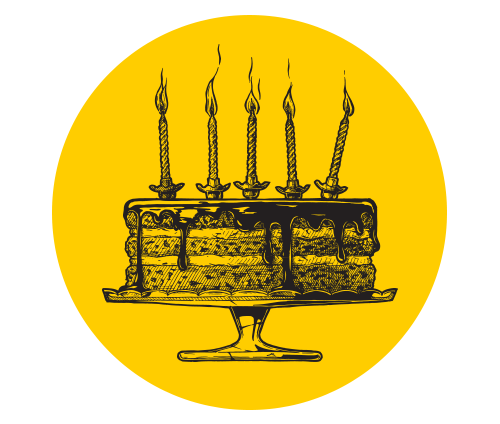Century of Support
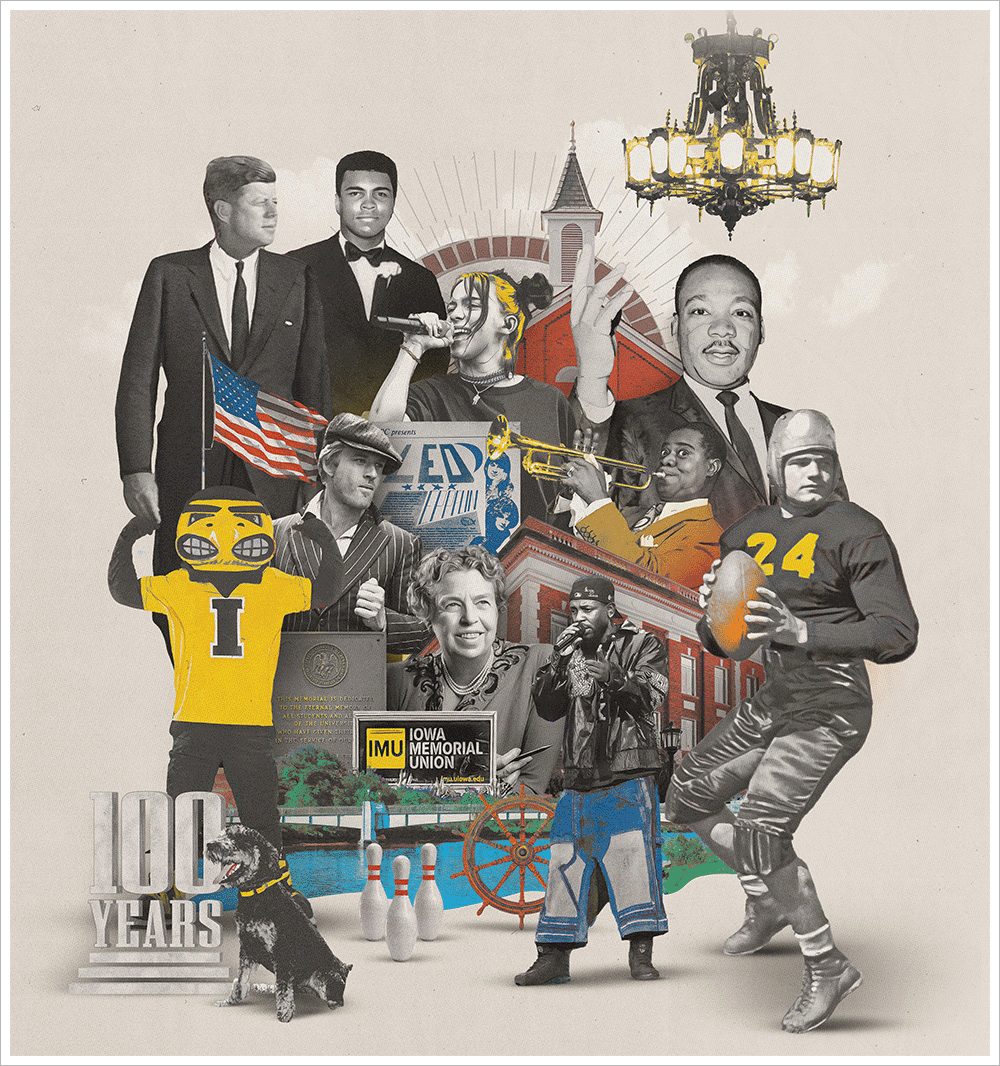 ILLUSTRATION: MAX-0-MATIC; FULL COLLAGE PHOTO CREDITS LISTED ON BOTTOM
ILLUSTRATION: MAX-0-MATIC; FULL COLLAGE PHOTO CREDITS LISTED ON BOTTOM
Whether it’s prospective students forming their first impressions on a campus tour, current Hawkeyes gathering for activities with their student organizations, or alumni stopping by the bookstore for a memento, there’s never a dull moment at the Iowa Memorial Union. The buzzing building at the heart of campus turns 100 in February, a milestone that the University of Iowa is celebrating all year.
Since its official dedication in 1926, the IMU has undergone many changes to meet the needs of students. A dry nightclub called the Silver Shadow, a classical music listening library, and a six-lane bowling alley are just a few features that have come and gone. The union has also weathered challenges, including the 2008 flood washing out the ground floor and the COVID-19 pandemic limiting its use. But even in the face of natural disasters, war, and the changing times, the IMU’s purpose has remained the same: to serve the university community.
In recognition of the IMU’s legacy and its ongoing importance to campus, the UI has launched an $81.4 million renovation project set for completion in 2027. The project will preserve the union’s character, while transforming it into a modern space where students can gather, grow, and more easily access the resources they need to succeed.
Plans include a student well-being center to bring university support services under one roof; renovated dining spaces with nationally branded food options; improved navigation and circulation throughout the building; updated meeting rooms, offices, and lounge areas to study and connect; and a leveled-up space for esports.
As the IMU marks a century at the center of the student experience, Hawkeyes can also look ahead to a new era in which the union’s offerings help students thrive at every stage of their UI journey.
 PHOTOS: UI OFFICE OF STRATEGIC COMMUNICATION
An $81.4 million renovation to modernize the 100-year-old Iowa Memorial Union for students began in summer 2025 and is estimated for completion by fall 2027. The updates include improvements to spaces where the campus community can gather, eat, and study.
PHOTOS: UI OFFICE OF STRATEGIC COMMUNICATION
An $81.4 million renovation to modernize the 100-year-old Iowa Memorial Union for students began in summer 2025 and is estimated for completion by fall 2027. The updates include improvements to spaces where the campus community can gather, eat, and study.
Cause for Construction
A key part of shaping that future is creating a campus well-being center that offers physical and mental health services. Currently on the west side of campus, Student Health, Student Wellness, and University Counseling Service will move to the IMU, taking space once occupied by the Iowa House Hotel. The former Iowa House Hotel’s transformation will complement other IMU improvements completed in 2023, when additional services like the food pantry were added to the union’s ground floor. These student-centric features are all part of the university’s strategic plan of “embedding well-being and mental health into all aspects of campus culture.”
Upholding that mission by placing Student Wellbeing Services within the union was a novel idea. Bill Nelson, associate dean and executive director of the IMU, says no other Big Ten university houses student health and counseling services in its union. When he’s spoken to other Big Ten union directors, Nelson says, “People are fascinated by what we’re doing here. People are interested in what these renovations will do in terms of redefining the student experience.”
Tanya Villhauer (87BS, 91MA), assistant dean of students for well-being and basic needs, says putting student wellness services in the IMU sends an important message. “We want our students to understand that we value their health and well-being,” she says. “We can show that by how we show up for them.”
Student-Driven Updates
Undergraduate Student Government President Thomas Knudsen and Vice President Emily Cross are among the Iowa students who have been advocating for the renovations. On any given weeknight, the two can be found attending meetings in the IMU for USG. USG and UI Graduate and Professional Student Government both supported the IMU project, which will be covered primarily by student fees, with help from donor funds.
When Knudsen and Cross decided to run for student leadership positions in spring 2025, they thought deeply about their goals—not only for USG, but for the extended campus community. A part of their campaign platform was enhancing campus spaces and championing mental health awareness to ensure students have convenient access to support services. “If students don’t know where to go or how to access those resources, they’re not going to use them,” says Cross, a UI junior studying marketing and event management.
Director of Student Health and Wellness Todd Patterson (14BA, 17MHA) reported that Student Health averaged 23,697 visits from fiscal years 2021–25. University Counseling Service averaged 11,000 appointments for each of the last three years. With the IMU location change, Patterson says, “We are looking forward to moving into a newly remodeled clinic to continue providing excellent health care for our UI students.”
The move comes at a time when the demand for student services and support is larger than ever. Pursuing higher education at an institution is a major life transition. For many students, college is the first time they are juggling academic, financial, and personal stressors on their own. Studies from the American Council on Education show that poor mental health leads to lower retention rates. For these reasons and more, Villhauer says, “Having accessible care is an important component of students’ success.”
 PHOTOS: UI OFFICE OF STRATEGIC COMMUNICATION
Over the years, many famous figures have visited the IMU—including musician Billie Eilish, pictured in the bottom photo
in 2018.
PHOTOS: UI OFFICE OF STRATEGIC COMMUNICATION
Over the years, many famous figures have visited the IMU—including musician Billie Eilish, pictured in the bottom photo
in 2018.
An Investment in the Future
A pre-law student, Knudsen graduates this spring—meaning he won’t see the final changes to the IMU until he becomes an alum. Even so, the senior views the building’s updates as a win for the university. “When the IMU renovations are done, it will be a focal point that students look at when deciding to attend the University of Iowa,” he says. “I’m very excited for the next generation of Hawkeyes who will be able to fully benefit from centralized services, the expansion of student workspaces, and the cool new food vendors.”
The next generation of Hawkeyes deserve extra consideration, especially given their size. When the undergraduate class of 2029 arrived on campus this past fall, they were 5,561 strong. This is the second-largest admitted undergraduate class Iowa has seen. More students mean more needs, and Knudsen and Cross see the IMU project as a long-term investment in current and future students.
Of course, the IMU is not just used by students—it’s frequented by alumni, community members, prospective and future Hawkeyes, friends, families, faculty, staff, and the general public. When Villhauer imagines the future of the IMU, she sees a revolving door with people constantly coming in and out. From public lectures and concerts to shopping and dining, the IMU is a space she views as offering something for everyone.
Nelson shares a similar vision. Because even when student activities and offerings within the IMU change, its 100-year tradition as the hub of campus life does not. More than just a building, the IMU is a place for making new connections and memories. As Nelson says, “It will always be the people who make the IMU special.”
Cheers to 100 Years
A celebration of this size calls for a stroll down memory lane. Over the past century, the Iowa Memorial Union has been the backdrop for many special moments on campus. Big band dances, famed visitors, student activism, and flood recovery efforts all add to the IMU’s rich history. Join Iowa Magazine as we revisit key milestones through the stories of Iowa alumni and staff who share meaningful connections with each era.
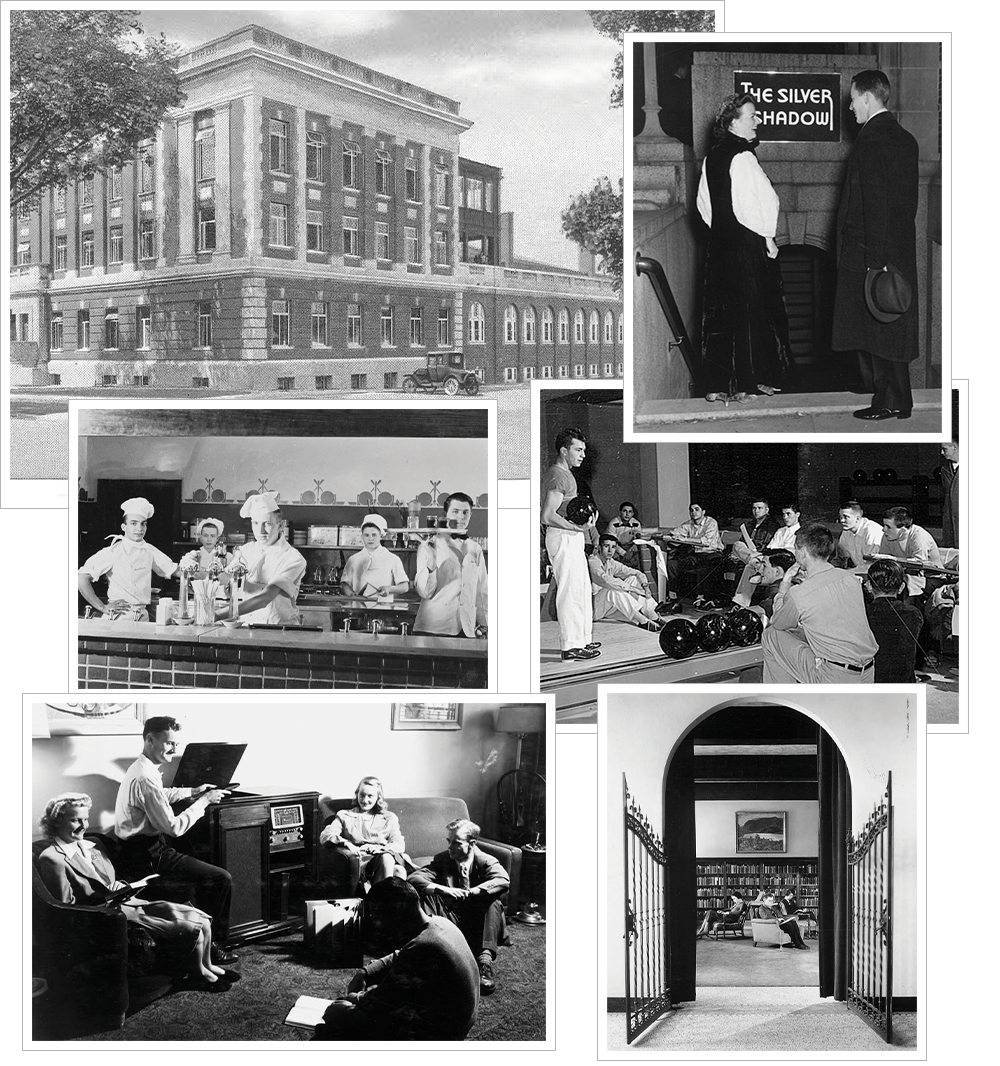 PHOTOS: UI LIBRARIES SPECIAL COLLECTIONS
AT LEFT, CLOCKWISE FROM TOP: Northeast view of the IMU, circa 1928; IMU night club, The Silver Shadow, 1937; bowling alley, 1955; IMU library, 1950s; reading and listening to music in an IMU lounge, 1950s; the Union Boys work the soda fountain, 1940s
PHOTOS: UI LIBRARIES SPECIAL COLLECTIONS
AT LEFT, CLOCKWISE FROM TOP: Northeast view of the IMU, circa 1928; IMU night club, The Silver Shadow, 1937; bowling alley, 1955; IMU library, 1950s; reading and listening to music in an IMU lounge, 1950s; the Union Boys work the soda fountain, 1940s
The M in IMU
Following the end of World War I, community leaders proposed a memorial on campus to honor the University of Iowa’s veterans. The university’s students and alumni embraced the effort and contributed significantly to the building fund. Construction of the Iowa Memorial Union began in 1924. Its doors opened the following year.
At the IMU’s dedication ceremony on Feb. 6, 1926, Des Moines attorney James Weaver (1882LLB) spoke of his vision for the building. He said, “If this magnificent structure is to fulfill the dreams out of which it has arisen, it can only do so by stirring the impulses of the young men and women of Iowa to lives of service to mankind.”
Young people answered that call in 1942 when the U.S. Navy selected Iowa as one of four major universities to house its pre-flight training program. Through 1944, Iowa hosted several thousand pilots-in-training, including future Hawkeye football coach Forest Evashevski and astronaut John Glenn. The IMU also fed and trained U.S. Army cadets during World War II.
The son of a World War II veteran, Major General Stewart Wallace (68BBA) remembers visiting the IMU’s veterans memorial wall with his father as a high school student. The memorial made an impression on Wallace that would help shape the course of his life. “If it wasn’t for those individuals, if they hadn’t given their lives to keep the country free, we wouldn’t be able to walk across campus or get an education,” he says.
After graduating from Iowa’s ROTC and business programs, Wallace was commissioned as second lieutenant in the U.S. Army. He served for 33 years, including 13 years overseas in Vietnam, Turkey, Germany, and Korea.
When Wallace officially retired in 2017, he revisited the IMU to speak at the ROTC spring ball. Refurbishing and updating the memorial wall on the first floor gave him a renewed sense of purpose. Wallace received a Hawkeye Distinguished Veterans Award in 2022 for his efforts in support of UI veterans and helped establish the IMU Veterans Plaza in 2023.
“There have been a lot of changes at the IMU, and it’s all for the better,” says Wallace. “But I hope young people who step into the IMU continue to recognize those willing to make the ultimate sacrifice, so that they can continue to learn and exchange ideas.”
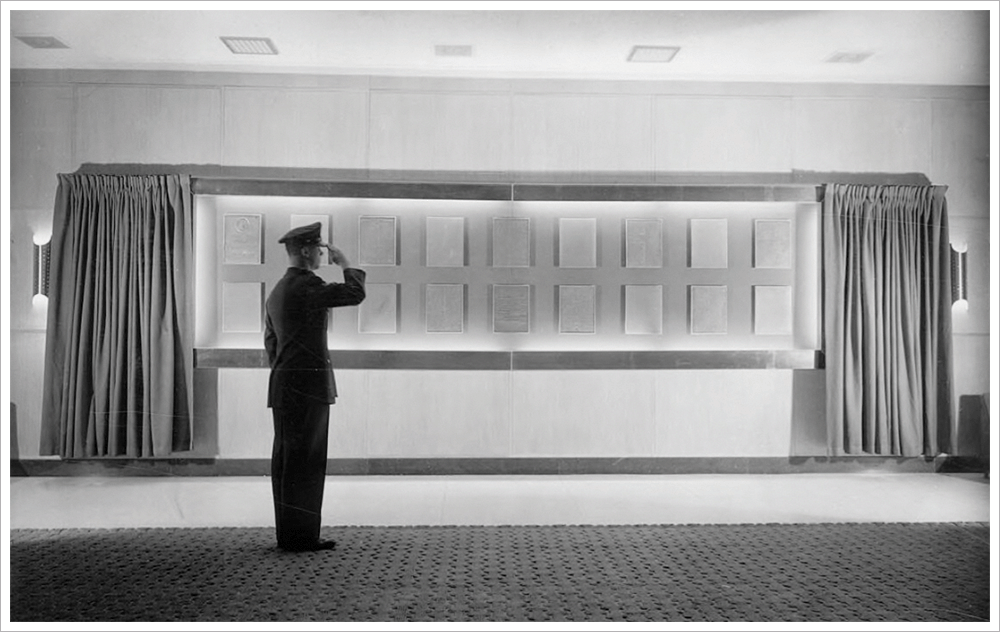 PHOTO: UI LIBRARIES SPECIAL COLLECTIONS
In this photo from the 1950s, a soldier salutes the memorial plaques at the IMU that honor university students and alumni who died in service. The display has since been updated, and a new Veterans Plaza outside the IMU recognizes UI veterans who have served in each of the six branches of the U.S. armed services.
PHOTO: UI LIBRARIES SPECIAL COLLECTIONS
In this photo from the 1950s, a soldier salutes the memorial plaques at the IMU that honor university students and alumni who died in service. The display has since been updated, and a new Veterans Plaza outside the IMU recognizes UI veterans who have served in each of the six branches of the U.S. armed services.
A Call to Action
 Click to enlarge
Click to enlarge
On Nov. 11, 1959, Martin Luther King Jr. spoke to a packed room in the Iowa Memorial Union. The civil rights leader’s message—delivered four years before his “I Have a Dream” speech at the March on Washington—focused on organizing efforts to address the discrimination Black Americans faced in the North. He said, “The Negro and white must join to make this more than a racial issue, but an issue between justice and injustice.”
According to University Archivist Emeritus David McCartney, King’s speech sparked a flurry of activism in Iowa City. Off campus, an undercover Daily Iowan investigation in 1962 revealed landlords on housing listings that were approved by the Office of Student Activities had barred Black students from living in their facilities. On campus, students embraced free speech through Soapbox Sound Off, a weekly forum where students could stand on a soapbox at the IMU and share whatever was on their mind.
The IMU was also a hub for student activists planning events on a national scale. In 1964, the Student Nonviolent Coordinating Committee recruited students from Iowa for Freedom Summer. Several students who felt compelled by the cause traveled to Mississippi, where they taught Black students at freedom schools and helped Black Americans register to vote. One student who made the trip was Stephen Smith. The Marion, Iowa, native would later become known as the first person to burn his draft card on a college campus following a federal law criminalizing the act. He did so during a Soapbox Sound Off on Oct. 20, 1965.
In the years that followed, students continued using their voices to address national and global issues, such as the Vietnam War. Students responded when Dow Chemical Co. came to the IMU’s Business and Placement Office in 1967. Dow Chemical’s goal was to interview Iowa students for jobs; however, the company was known for creating napalm, a gel-like mixture of gasoline and chemicals developed for the war. The controversial chemical caused severe burns, not only to forests but to soldiers and civilians on the ground. In protest of the company, 200 students linked arms and formed a human chain around the IMU’s perimeter, barring people from entering. Protestors later clashed with police, who arrested 18 people.
These are just some of the events that happened at the IMU during this tumultuous period of social, political, and cultural change, which motivated many students to act. As McCartney looks toward the future of Iowa’s union, he says, “My hope is that the IMU, within the law, can continue to function as place for people to freely exchange ideas.”
 PHOTOS: UI LIBRARIES SPECIAL COLLECTIONS
LEFT: UI student activist Stephen Smith, who participated in the Freedom Summer of 1964 to support civil rights, burns his draft card at the IMU in 1965 to protest the Vietnam War; RIGHT: In 1967, police arrest a student who was part of a protest outside the IMU against Marine recruitment during the Vietnam War.
PHOTOS: UI LIBRARIES SPECIAL COLLECTIONS
LEFT: UI student activist Stephen Smith, who participated in the Freedom Summer of 1964 to support civil rights, burns his draft card at the IMU in 1965 to protest the Vietnam War; RIGHT: In 1967, police arrest a student who was part of a protest outside the IMU against Marine recruitment during the Vietnam War.
The Dawn of Dance Marathon
Over the years, the Iowa Memorial Union has served as a gathering space for hundreds of student organizations. The largest of the 600 groups active today launched in 1994, when the Children’s Miracle Network had an idea to start a dance marathon to support local pediatric cancer patients. It would be modeled after THON, a similar event hosted at Penn State.
Fraternity leader Chris Metzger (95BS) hopped in a car with fellow UI students and drove to State College to see the event for himself. Twelve hours in, he realized that a dance marathon fundraiser could work at Iowa.
 PHOTOS: UI OFFICE OF STRATEGIC COMMUNICATION
Dance Marathon, the largest student organization on campus, has used the IMU since 1995 to host its annual fundraiser for local pediatric cancer patients.
PHOTOS: UI OFFICE OF STRATEGIC COMMUNICATION
Dance Marathon, the largest student organization on campus, has used the IMU since 1995 to host its annual fundraiser for local pediatric cancer patients.
As Iowa’s first Dance Marathon executive director, Metzger returned to campus to scope out venues big enough for the event, considering locations like the Field House. “The IMU was pretty much the only place that would have us,” he says. According to Metzger, devoted staff like Lisa Baum of the Children’s Miracle Network at University of Iowa Hospitals & Clinics and Mary Peterson (79BS, 88MA) of the University Life Centers were catalysts for the idea. David Grady, director of the Office of Campus Programs and Student Activities, helped give the beloved Iowa tradition a home in the IMU. Metzger was then trusted to bring the vision to life.
After a year of planning, the first Dance Marathon was held in the IMU Main Lounge in 1995 and raised $31,000. Now approaching its 32nd event in February, the organization has raised more than $37 million in total for youth cancer patients and their families.
Although the Big Event has grown considerably since its inception, the IMU continues to host Dance Marathon. “The IMU still carries the spirit of what Iowa is, who the students are, and what Dance Marathon is fighting for,” says Metzger. “Those memories, those relationships, those moments that you create, they stick with you.”

